- Home
- About
- Map
- Trips
- Bringing Boat West
- Migration West
- Solo Motorcycle Ride
- Final Family XC Trip
- Colorado Rockies
- Graduates' XC Trip
- Yosemite & Nevada
- Colorado & Utah
- Best of Utah
- Southern Loop
- Pacific Northwest
- Northern Loop
- Los Angeles to NYC
- East Coast Trips
- Martha's Vineyard
- 1 Week in Quebec
- Southeast Coast
- NH Backpacking
- Martha's Vineyard
- Canadian Maritimes
- Ocracoke Island
- Edisto Island
- First Landing '02
- Hunting Island '02
- Stowe in Winter
- Hunting Island '01
- Lake Placid
- Chesapeake
- Provincetown
- Hunting Island '00
- Acadia in Winter
- Boston Suburbs
- Niagara Falls
- First Landing '99
- Cape Hatteras
- West Coast Trips
- Burning Man
- Utah Off-Roading
- Maui
- Mojave 4WD Course
- Colorado River Rafting
- Bishop & Death Valley
- Kauai
- Yosemite Fall
- Utah Off-Road
- Lost Coast
- Yosemite Valley
- Arizona and New Mexico
- Pescadero & Capitola
- Bishop & Death Valley
- San Diego, Anza Borrego, Joshua Tree
- Carmel
- Death Valley in Fall
- Yosemite in the Fall
- Pacific Northwest
- Utah Off-Roading
- Southern CA Deserts
- Yosemite & Covid
- Lake Powell Covid
- Eastern Sierra & Covid
- Bishop & Death Valley
- Central & SE Oregon
- Mojave Road
- Eastern Sierra
- Trinity Alps
- Tuolumne Meadows
- Lake Powell Boating
- Eastern Sierra
- Yosemite Winter
- Hawaii
- 4WD Eastern Sierra
- 4WD Death Valley +
- Southern CA Deserts
- Christmas in Tahoe
- Yosemite & Pinnacles
- Totality
- Yosemite & Sierra
- Yosemite Christmas
- Yosemite, San Diego
- Yosemite & North CA
- Seattle to Sierra
- Southwest Deserts
- Yosemite & Sierra
- Pacific Northwest
- Yosemite & South CA
- Pacific Northwest
- Northern California
- Southern Alaska
- Vancouver Island
- International Trips
- Index
- Tips
- Books
- Photos/Videos
- Search
- Contact
Seltún Geothermal Area, Iceland
Sunday, June 11, 2023 - 11:00am by Lolo
128 miles and 2.75 hours from our last stop
Travelogue
 Gas Station $3 hot dogAs we left the Snæfellsnes Peninsula and headed south to Grindavik, the realization hit that our trip was soon coming to an end.
Gas Station $3 hot dogAs we left the Snæfellsnes Peninsula and headed south to Grindavik, the realization hit that our trip was soon coming to an end.
We had accomplished an awful lot and seen so much of the beauty and culture of Iceland. However, there was one important part of Icelandic culture we had not experienced yet - the $3 gas station hot dog.
Iceland’s gas stations don’t just sell fuel. They also serve as a combination coffee shop, restaurant, grocery store, retail store and community center. Some even sell knitting supplies and farm implements.
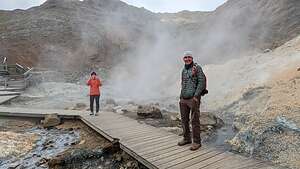 Seltún Geothermal AreaA whole culture has developed around these stations and most locals have no problem dining out at the local N1. With the price of food at restaurants in Iceland, it’s a bargain, especially the $3 hot dogs.
Seltún Geothermal AreaA whole culture has developed around these stations and most locals have no problem dining out at the local N1. With the price of food at restaurants in Iceland, it’s a bargain, especially the $3 hot dogs.
I love immersing myself in the culture of a country. It's natural beauty isn't good bad either.
On our way to Grindavik, we decided to stop at the colorful Seltun Geothermal Area, not as large and dramatic as the Hverir Geothermal Area in Lake Myvatn, but still it has its fair share of steaming volcanic vents, fumaroles, mud pots and boiling hot springs.
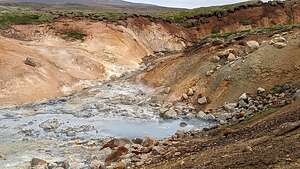 Seltún Geothermal AreaIts close proximity to Reykjavik (just 25 miles), and to the parking lot, makes it a popular place to visit, as it was today.
Seltún Geothermal AreaIts close proximity to Reykjavik (just 25 miles), and to the parking lot, makes it a popular place to visit, as it was today.
After parking we headed out along a boardwalk that wound its way through the bubbling and hissing field. These are necessary to keep foolish people from stepping on the volcanic crust, breaking through, and scalding their feet - which as happened. The steam from a fumerole can well exceed 200 °F.
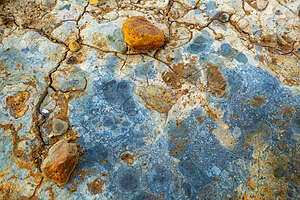 Colors of the Seltún Geothermal AreaI love the colors from the rich variety of minerals found in geothermal areas, especially the blues, greens, oranges, and yellows.
Colors of the Seltún Geothermal AreaI love the colors from the rich variety of minerals found in geothermal areas, especially the blues, greens, oranges, and yellows.
There were some whites and browns mixed in as well. Those are the sulfates but when it rains, they dissolve in water while the other minerals don't, leaving the brighter colors behind like at artist's palette.
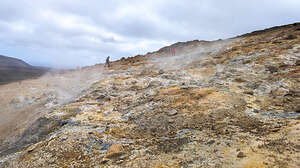 Climbing the hill above the Seltun Geothermal AreaWe left the safety of the boardwalk and began climbing through the steam up a steep, rocky hill of lava rocks to the 400-foot summit.
Climbing the hill above the Seltun Geothermal AreaWe left the safety of the boardwalk and began climbing through the steam up a steep, rocky hill of lava rocks to the 400-foot summit.
The view from the top was definitely worth the climb. The hills were painted in earthy hues of golden brown, red, yellow, white, and gray, with Lake Kleifarvatn in the distance.
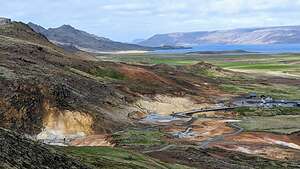 View from the hill above the Sulten Geothermal AreaThe lake lies on the fissure zone of the Mid-Atlantic Ridge, so this is still a very active geothermal area.
View from the hill above the Sulten Geothermal AreaThe lake lies on the fissure zone of the Mid-Atlantic Ridge, so this is still a very active geothermal area.
The way back down across the rough path was like walking through an alien landscape of jagged moss-covered lava rocks.
In 1999 an explosion occurred near here when an experimental drill hole from 1948 got clogged up with deposits and blew up, creating a beautiful little geothermal pond. The explosion was so massive that it destroyed the coffee shed by Seltún.
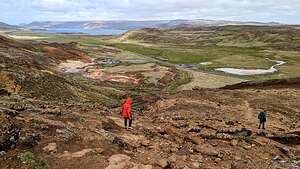 Back down through the lava fieldIn 2010 another drill hole near the path started spouting hot mud, so it was tightly closed. The moral of the story is this is still an active volcanic area, and you don’t mess with that.
Back down through the lava fieldIn 2010 another drill hole near the path started spouting hot mud, so it was tightly closed. The moral of the story is this is still an active volcanic area, and you don’t mess with that.
Now it was on the Grindavik where we would spend the last two nights of our Icelandic adventure - packing up, prepping the camper van for return, and, of course, visiting the famous Blue Lagoon.
Surprisingly Grindavik is much closer to the Keflavik Airport (Iceland's International Airport) than Reykjavik is.
- ‹ previous
- 27 of 30
- next ›
Seltún Geothermal Area location map in "high definition"
Javascript is required to view this map.
